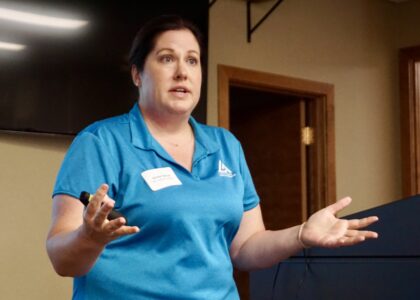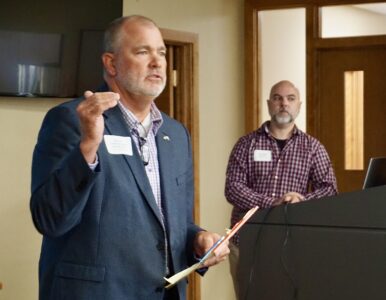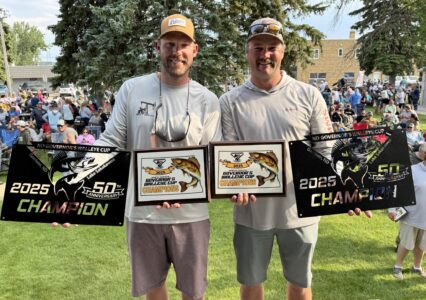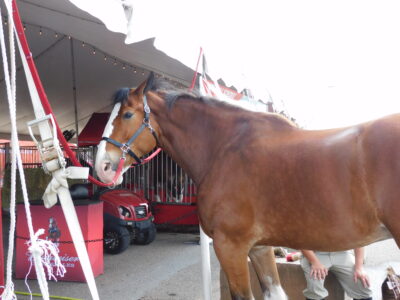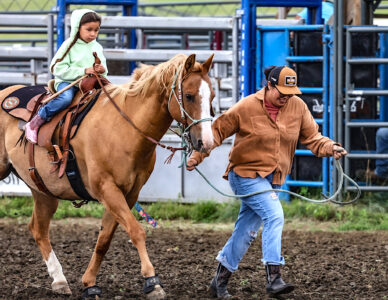Site analysis highlights regional livestock opportunities
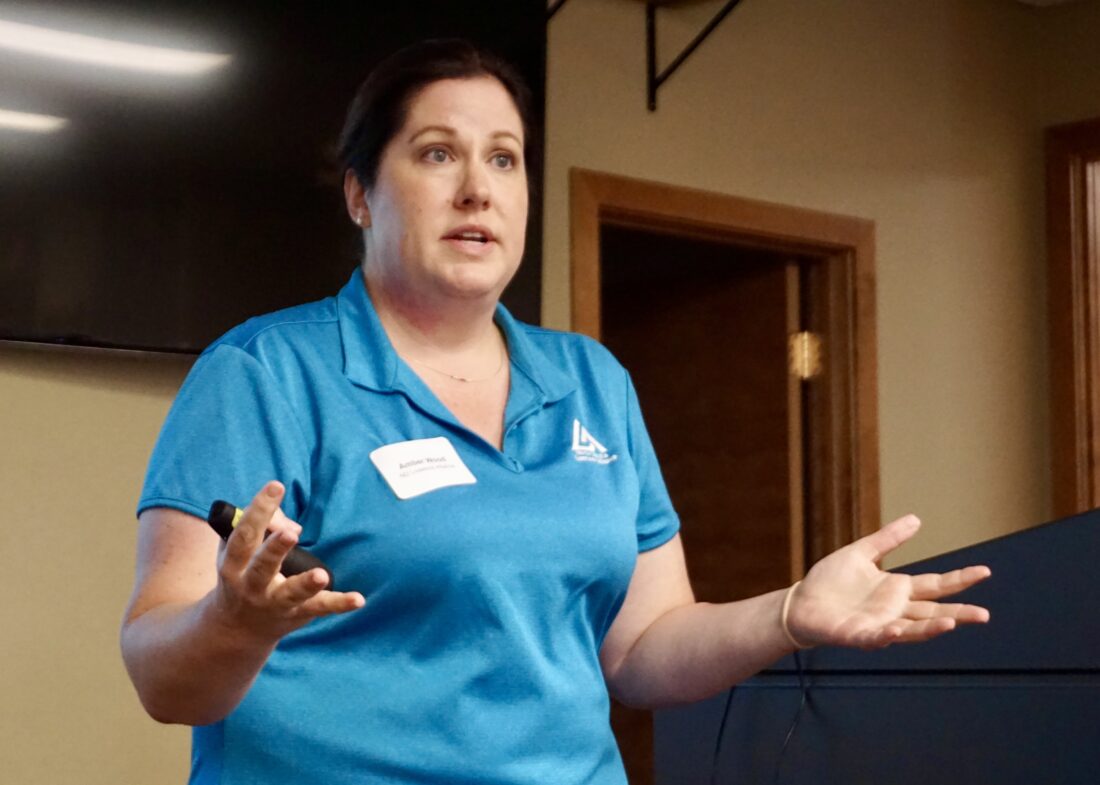
Jill Schramm/MDN Amber Wood, executive director for the North Dakota Livestock Alliance, speaks at a livestock development meeting held by Souris River Planning Council at Verendrye Electric Cooperative’s Minot office July 22.
A recently completed site analysis identifying the best locations for livestock development in the Minot region is more than just a mechanism for attracting huge operations, according to Todd Kays, executive director at First District Association of Local Governments.
“For this part of the state of North Dakota, we don’t have to site a 30,000 head dairy, like they did in DeSmet (South Dakota), or a 10,000 head dairy that Riverview is doing south of Fargo. We could grow family farming operations to raise 1,000 head of cows, or 2,500 head of pigs,” Kays told local government officials, planners, producers and others at a livestock development meeting in Minot July 22.
Souris Basin Planning Council served as the lead for the site analysis in its eight-county region, contracting with First District ALG in northeastern South Dakota to complete the study to determine the most suitable properties for different types of livestock operations.
The study included Bottineau, Burke, McHenry, Pierce, Mountrail, Renville and Ward counties. The process was funded through a statewide grant program created by the 2023 Legislature.
SBPC and First District ALG have been releasing county-specific findings to each county and presented an overview of those findings July 22.

Jill Schramm/MDN Tom Bodine, deputy commissioner with the North Dakota Department of Agriculture, speaks at a livestock development meeting in Minot July 22. At right is Erin Parker, economic development specialist with Souris Basin Planning Council.
The analysis found 2,275 locations in the eight-county region suitable as good, better or best sites, with half mile setbacks, for the operations of 1,000 feeder cattle or 2,500 finisher hogs. Fewer total sites, 541, were identified for 5,000 head diaries or sow operations with one mile setbacks.
“We’re not making the claim that these are the only sites in the county,” Kays said. “Our intent is to find the best places for these to grow.”
The site analysis is useful for determining where local governments might want to add infrastructure to create more suitable livestock sites as well as to give landowners potential opportunities to develop or market their properties for development.
The key in permitting new operations is to be open and transparent, said Amber Wood, executive director for the North Dakota Livestock Alliance, who presented at the SBPC meeting.
“We have realized that the best way for animal agriculture to be successful in the state of North Dakota, people have got to know what’s going on. You don’t want to be moving dirt and have a neighbor come over and say, ‘Hey, what are they doing?’ You want everybody to know what’s going on before that moving dirt stage comes in,” she said.
The alliance, founded in 2017 with representation from a number of agriculture groups, seeks to strengthen rural communities, farm and ranch families, businesses and natural resources through animal agriculture.
Among its activities are helping counties and townships review zoning ordinances and working with producers to assist with permitting processes for livestock operations.
Wood said opposition to livestock operations often focuses on large, out-of-state facilities coming into North Dakota, but it is existing, young producers who end up stymied by the resulting zoning and setbacks.
“So, just be very cautiously aware to not inadvertently exclude your existing producers from being able to expand or diversify because that is going to be essential to the success of our multi-generational farms,” she said.
The alliance also trains local individuals to become livestock friendly spokespersons who can provide accurate, scientifically based information on livestock development.
“Why are we seeing more animals being fed in confinement in the state of North Dakota? We can better protect animals from adverse weather. We’re able to provide constant, high quality water and constant high quality feed. And we can pay attention on an individual animal basis to make sure that we have precision care for those animals,” Wood said.
She also talked about the economic value of animal manure, a high quality nutrient resource for cropland. Operational improvements and carefully engineered plans have led to odor mitigation measures both at the barnyard and in the fields, where manure is injected 6 inches below the oil surface for plants to utilize, she said.
Nor is manure going to be applied in a way that it seeps into waterways because it is a high value nutrient source, scientifically applied based on soil need, she added.
Livestock operations also provide value-added use for feedstocks that in-state ethanol or soybean crushing plants are shipping out of state, Wood said.
In the end, the alliance wants everyone to be excited about livestock development, Wood said.
“Because this is such an opportunity,” she said.
“When you look at how much open space we have, look at all the opportunities on the grains that provide value to animal agriculture, we’re not taking advantage of it,” said Tom Bodine, deputy commissioner with the North Dakota Department of Agriculture, who noted North Dakota ranks 38th among states in livestock value.
Bodine outlined several state initiatives to promote livestock development, including a model zoning ordinance and the $1.2 million for the site analysis statewide.
Among programs to assist with agriculture development, the Agricultural Products Utilization Commission supports research, agri-tourism, expansion into non-traditional crops and livestock, technical assistance, prototypes and technology, and market analysis and planning.
The Agriculture Diversification Development Fund supports new and expanding value-added animal feedlots, with a program developed this year that can assist with capital expenses of dairy projects. A Livestock Pollution Prevention Program offers cost share assistance for waste containment systems.
Additionally, counties are able to apply for infrastructure grants for roadways, bridges and utility improvements to support livestock development.
- Jill Schramm/MDN Amber Wood, executive director for the North Dakota Livestock Alliance, speaks at a livestock development meeting held by Souris River Planning Council at Verendrye Electric Cooperative’s Minot office July 22.
- Jill Schramm/MDN Tom Bodine, deputy commissioner with the North Dakota Department of Agriculture, speaks at a livestock development meeting in Minot July 22. At right is Erin Parker, economic development specialist with Souris Basin Planning Council.

